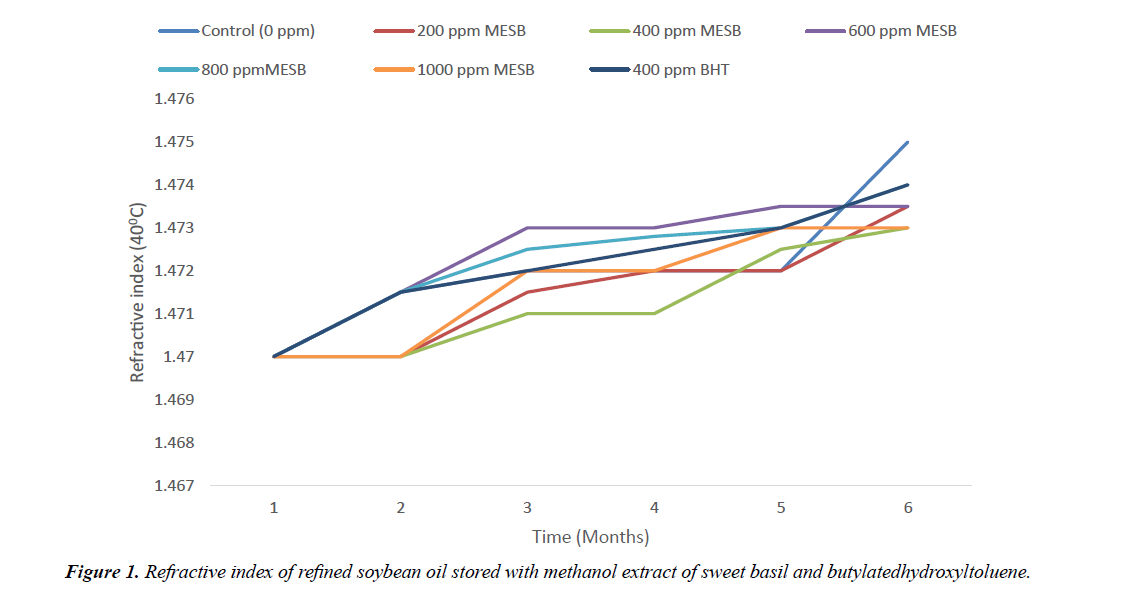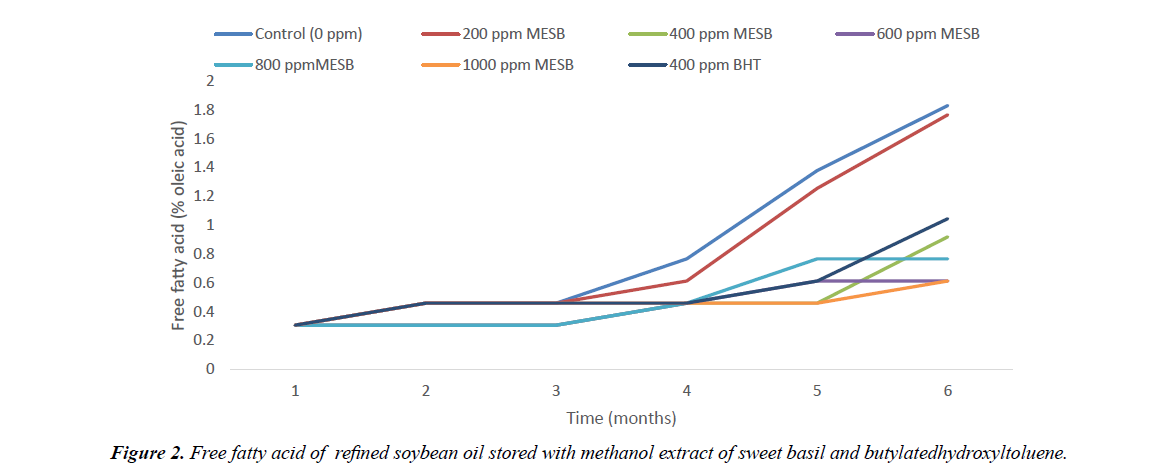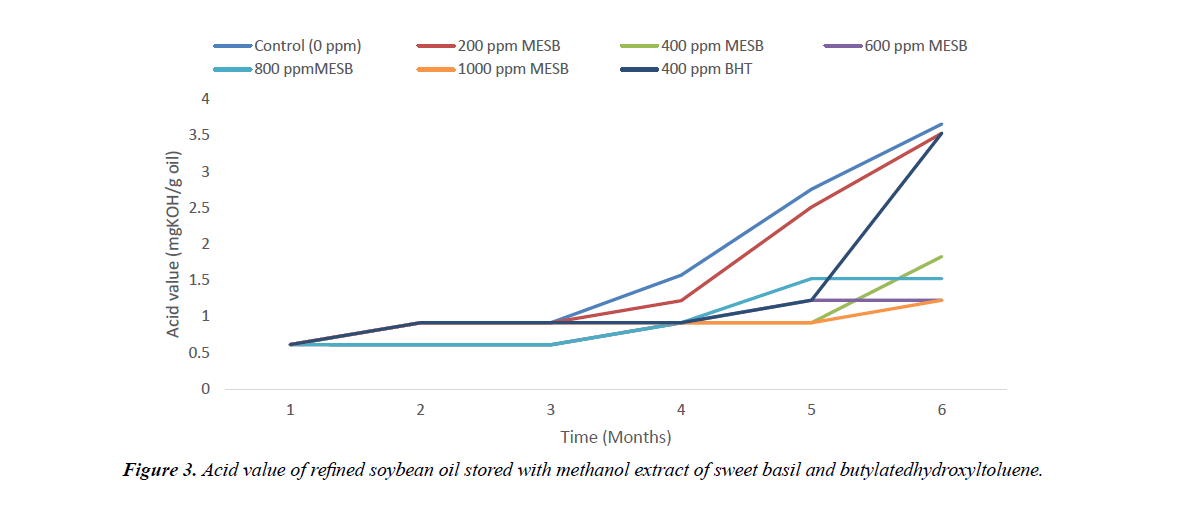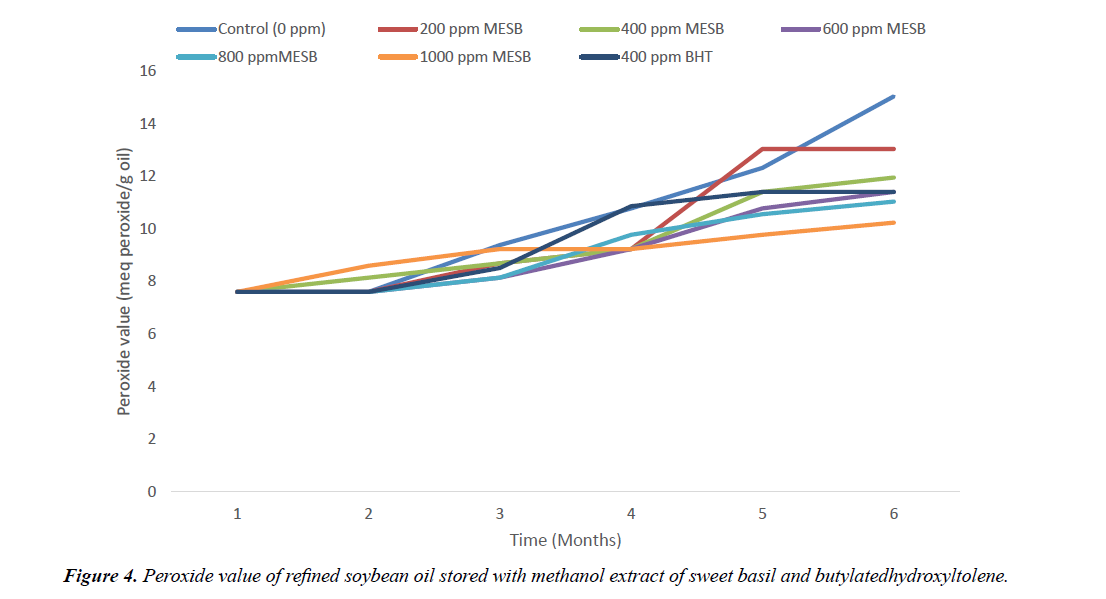Research Article - Journal of Food Technology and Preservation (2018) Volume 2, Issue 2
Comparison of antioxidative potentials of methanol sweet basil (Ocimum basilicum) extract and butylatedhydroxyltoluene on stability of refined soybean oil.
Arawande JO*
Department of Chemistry, University of Medical Sciences, Nigeria
- *Corresponding Author:
- Arawande JO
Department of Chemistry
University of Medical Sciences
Nigeria
Tel: +2348034391608
E-mail: joawande1@yahoo.com
Accepted Date: June 18, 2018
Citation: Arawande JO. Comparison of antioxidative potentials of methanol sweet basil (Ocimum basilicum) extract and butylatedhydroxyltoluene on stability of refined soybean oil. J Food Technol Pres. 2018;2(2):11-6
Abstract
Sweet basil leaves were obtained from a backyard garden at Oka in Ondo-City, Nigeria. The
leaves were rinsed with water to remove the dirt, air-dried and ground to powdery sample. The
leaf sample was then extracted with methanol by adding 20 g of the powdery sample into 200 mL
of methanol and left it for 72 hours. The extract was obtained by concentrating the filtrate from
the mixture in a rotary evaporator. The extract was dosed at varying concentration (200-1000
ppm) to refined soybean oil (RSBO). Another set up was made by dosing RSBO with 400 ppm
butylatedhydroxyltoluene (BHT). A control which contained no additive (0 ppm) was also set up.
The oil was stored in a transparent plastic bottle for five months. The antioxidative potential of
methanol extract of sweet basil (MESB) at varying concentrations (200-1000 ppm) was compared
with 400 ppm BHT on RSBO by monthly monitoring their refractive index (RI), free fatty acid
(FFA), acid value (AV) and peroxide value (PV) for five months. There was no remarkable
difference in RI of RSBO containing additives and that of the control sample. The mean value
of FFA, AV and PV of RSBO containing MESB were lower than the RSBO containing 400 ppm
BHT over the five months of storage. There were significance difference (P<0.05) in average FFA,
AV and PV of RSBO containing MESB, BHT and RSBO without additive. It is therefore noticed
that MESB is superior to BHT in combating both hydrolytic and oxidative rancidity of RSBO.
Keywords
Refined soybean oil, Sweet basil, Stability, Methanol extract, Antioxidants.
Introduction
Refined soybean oil is an edible oil obtained from soybean seeds and the oil contains more unsaturated fatty acid than saturated fatty acid hence it is a liquid at room temperature [1]. The crude soybean oil is often obtained from soybean seeds through solvent extraction using n-hexane [2]. The crude oil is being processed to refined oil by subjecting it to degumming, neutralization, bleaching and deodorization [3]. The refined oil has a superb organoleptic and nutritive qualities hence it is relatively more expensive than most of the commonly available edible oils like palm oil, palm kernel oil, groundnut oil etc. Being an edible oil, refined soybean oil is also prone to deterioration during storage and the deterioration is termed rancidity which can be hydrolytic and/or oxidative. An indiscriminate consumption of rancid oil by humans has been found to be a major cause of heart related diseases such as heart failure, stroke, hypertension, thrombosis, obesity, atherosclerosis etc. [4-7].
Consequently, there is a need to preserve edible oils from going rancid by addition of additives which will delay the onset of both hydrolytic and oxidative rancidity. Most of these additives are antioxidants that reduce oxidative damage caused by highly reactive chemicals (free radicals) that attack oil molecules. Common synthetic antioxidants such as propyl gallate, butylatedhydroxylanisole, butylatedhydroxyltoluene, tertiarybutylatedhydroxylquinone etc. have been found effective in prolonging the shelf life of edible oils but they are also being found to be carcinogenic, toxic, mutagenic, costly and not ready available [8-10]. Due to the foregoing reasons, the usage of these synthetic antioxidants as additives or preservatives is being banned in the international market [11,12]. This necessitates the rousing interest of food chemists, nutritionists and scientists in seeking for alternative sources that are cheaper and safer from plant origin by using plant extracts as additives in combating vegetable oil rancidity during storage [13-17].
Sweet basil originated from India and it is botanically known as Ocimum basilicum. It is a culinary herb which prominently features in Italian cuisine of Taiwan. It is an annual plant which requires tropical climate. Sweet basil is 30-130 cm tall with silky leaves which are 3 cm long and 1 cm broad. Its flowers are small, white in colour and arranged in a terminal spikes [18]. The plant has a distinct scent and an essential oil called eugenol. The distinct scent is produced as a result of some of the chemical composition present in the plant such as citronellol, mycenae, tarpileol, octanes, methyl eugenol, eugenol etc. [19]. The sweet basil leaves have been found to contain carbohydrate, dietary fibre, fat, protein, water, vitamin A, B1, B2, B3, B6, C, E and K as well as minerals [20]. The leaves are traditionally used as supplementary treatment for stress, asthma, diabetes and also used in medicine for treating pimples [21]. Consequently, this suggests that the plant contains phytochemicals that have antioxidant properties.
Therefore the focus of this research is to obtain extracts from sweet basil leaves using methanol; investigating the antioxidative potential of the extract at varying concentrations (200-1000 ppm) on refined soybean oil; determining the effect of the extract on refractive index of the oil as well as comparing the antioxidant activities of the extracts with that of butylatedhydroxyltoluene (400 ppm BHT) by monthly monitoring their free fatty acid (FFA), acid value (AV) and peroxide value (PV) during five months storage of the oil in white transparent plastic bottles.
Materials and Methods
Sources of materials
Sweet basil leaves were obtained from a backyard garden at Oka in Ondo-City, Ondo-State, Nigeria. The refined soybean oil was obtained before being fortified with vitamin A at JOF Ideal Family Farms Limited, Owo, Ondo-State, Nigeria.
Preparation and extraction of sweet basil leaves
The sweet basil leaves were removed from their stems, rinsed with water and cut into smaller pieces for easy air-drying. The dried leaves were ground using electric blending machine and it was sieved with 40 mm mesh size. The powdery samples were packed into a black polyethene bags labelled appropriately prior to extraction. Twenty gram of the powdery sample was weighed into a cleaned and dried reagent bottle; and 200 mL of methanol was added to the bottle and left for 72 hours during which it was intermittently shaken on a shaking orbit machine. The mixture was filtered through a 0.45 μm Nylon membrane filter. The extract was evaporated to dryness under reduced pressure at 40°C by a rotary evaporator [15,22].
Addition of additives to refined soybean oil (RSBO)
Methanol extract of sweet basil leave at concentration of 200 ppm (0.02 g per 100 mL oil) to 1000 ppm (0.10 g per 100 mL oil) were separately added to refined soybean oil (RSBO) contained in white transparent plastic bottles of equal capacity and they were thoroughly shaken for proper mixing. RSBO containing 400 ppm BHT (0.04 g per 100 mL oil) and that which contained no additive (0 ppm (control)) were also set-up. Each container was appropriately labelled and stored in an open place at room temperature ranging from 29°C to 35°C.
Physical and chemical analysis
As soon as the set up was done, the refractive index (RI) was determined using Abbe’s Refractometer at 40°C. Thereafter, the refractive index (RI), free fatty acid (FFA), acid value (AV), and peroxide value (PV) of each oil sample were monitored monthly using standard method of analysis [23] for a period of five months.
Statistical analysis
The results were compared by one-way analysis of variance (one-way ANOVA) to test for significant difference. Means of the group were compared using Duncan Multiple Range Test (DMRT) [24].
Results and Discussion
Figure 1 presents the refractive index of refined soybean oil stored with varying concentrations (200-1000 ppm) of methanol extract of sweet basil (MESB) and 400 ppm butylatedhydroxyltoluene (BHT) for a period of five months. There was gradual increase in the refractive index of the oil samples stored for five months but the values were still within the accepted standard of 1.470- 1.476 specified by Standards Organization of Nigeria [25]. Detailed discussion on the refractive index of refined soybean oil stored with the additives is made in Table 1 where the overall average for the five months can be conspicuously observed.
Table1: Mean values of selected identity and quality properties of refined soybean oil stored with varying concentration of methanol extract of sweet basil (MESB) and 400 ppm butylatedhydroxyltoluene (BHT) over a period of five months
| Concentration of Additive | *Refractive Index (RI) (at 40°C) | *Free Fatty Acid (FFA) (% Oleic acid) | *Acid Value (AV) (mgKOH/g oil) | *Peroxide Value (PV) (meqO2/Kg oil) |
|---|---|---|---|---|
| Control (0 ppm) | 1.475a ± 0.002 | 0.867e ± 0.608 | 1.739e ± 1.215 | 10.460d ± 2.898 |
| 200 ppm MESB | 1.473a ± 0.001 | 0.810d ± 0.575 | 1.618d ± 1.151 | 9.510bc ± 1.967 |
| 400 ppm MESB | 1.473a ± 0.001 | 0.460ab ± 0.237 | 0.915ab ± 0.472 | 8.786a ± 1.663 |
| 600 ppm MESB | 1.474a ± 0.001 | 0.434a ± 0.151 | 0.866a ± 0.302 | 9.149ab ± 1.475 |
| 800 ppm MESB | 1.474a ± 0.001 | 0.485b ± 0.226 | 0.970b ± 0.400 | 9.330b ± 0.936 |
| 1000ppm MESB | 1.473a ± 0.001 | 0.460ab ± 0.097 | 0.916ab ± 0.194 | 9.557c ± 1.494 |
| 400 ppm BHT | 1.474a ± 0.001 | 0.557c ± 0.258 | 1.113c ± 1.086 | 9.572c ± 1.859 |
NOTE: Within each column, mean values followed by the same superscript are not significantly different at P<0.05 level according to Duncan Multiple Range Test (DMRT).*Mean Value ± Standard Deviation.MESB: Methanol Extract of Sweet Basil; BHT: Butylatedhydroxyltoluene.
Figure 2 depicts the free fatty acid (FFA) of refined soybean oil (RSBO) stored with varying concentrations (200-1000 ppm) of methanol extract of sweet basil and 400 ppm butylatedhydroxyltoluene for a period of five months. The oil sample containing additives has lower free fatty acid than the oil sample without any additive (control) (0 ppm). Refined soybean oil containing 400 ppm to 1000 ppm methanol extract of sweet basil (MESB) has lower free fatty acid than refined soybean oil containing 400 ppm butylatedhydroxyltoluene (BHT). There were gradually decrease in the free fatty acid of RSBO as the concentration of MESB increased from 200 ppm to 1000 ppm. The FFA plot resembles the plot obtained for FFA of palm kernel oil stored with varying concentration of sweet orange peel extract as reported by Arawande et al. [26]. Further discussion on the average effect of the additives on free fatty acid of RSBO is contained in Table 1 discussion.
Acid value (AV) of refined soybean oil stored with varying concentration (200-1000 ppm) of methanol extract of sweet basil and 400 ppm butylatedhydroxyltoluene for a period of five months is shown in Figure 3. The AV plot resembles the plot obtained for AV of palm kernel oil stored with varying concentration of sweet orange peel extract as reported by Arawande et al. [26]. RSBO containing additives have lower acid value than the RSBO which contained no additive (0 ppm). It was observed that the acid value of RSBO containing methanol extract of sweet basil (MESB) decreased as the concentration of the extract increased in the oil sample. However, further discussion on the average effect of the additives on acid value of RSBO is contained in Table 1 discussion.
Figure 4 presents the peroxide value of refined soybean oil stored with varying concentration (200-1000 ppm) methanol extract of sweet basil and 400 ppm butylatedhydroxyltoluene for five months. The trend of the plot is very similar to the plot obtained by Amir et al. [15] for the plot of peroxide value of soybean oil mixed with pistachio hull extract. The oil sample containing additives have relatively lower peroxide values than the oil sample without any additive (control (0 ppm)). The RSBO containing 200 ppm-1000 ppm of methanol extract of sweet basil (MESB) had slightly lower peroxide value than RSBO containing 400 ppm BHT.
Table 1 shows the mean values of selected identity and quality properties of refined soybean oil stored with varying concentrations of methanol extract of sweet basil (MESB) and 400 ppm butylatedhydroxyltoluene (BHT) over a period of five months. The identity property examined is refractive index (RI) while the quality properties considered are free fatty acid (FFA), acid value (AV) and peroxide value (PV). Refractive index of edible oil is an important physical identity parameter used to determine the level of purity of oil [27,28]. The addition of varying concentration (200-1000 ppm) of MESB to RSBO did not have much significant difference on the refractive index of RSBO. The average RI of RSBO containing 200-1000 ppm MESB was 1.473 ± 0.001 and 1.474 ± 0.001 while average RI of RSBO that contained no additive was 1.475 ± 0.002. The average RI of RSBO containing 400 ppm BHT was 1.474 ± 0.001. There was no significance difference (P<0.05) in average RI of RSBO containing additives (MESB and BHT) and RSBO which contained no additive (control (0 ppm)). Therefore the presence of the additives in RSBO did not adulterate the oil.
The free fatty acid and acid value of edible oil is a measure of hydrolytic rancidity. The lower the values of both FFA and AV the better the quality of the oil and more stable is the oil against hydrolytic rancidity [28,29]. The mean FFA of RSBO containing MESB ranged between 0.434 ± 0.151 and 0.810 d ± 0.575% oleic acid while the mean FFA of RSBO containing 400 ppm BHT had FFA of 0.557 ± 0.258% oleic acid. The mean FFA of RSBO which contained no additive (0 ppm) was 0.867e ± 0.608% oleic acid. The mean FFA of RSBO containing 400 ppm to 1000 ppm MESB was lower than mean FFA of RSBO stored with 400 ppm BHT. Apart from RSBO which contained 400 ppm and 1000 ppm MESB, the mean FFA of RSBO stored for five months was significantly different (P<0.05). The average AV of RSBO containing MESB ranged between 0.915 ± 0.472 and 1.618 ± 1.151 mg KOH/g oil and the average AV of RSBO without additive (control (0 ppm)) was 1.739 ± 1.215 mg KOH/g oil while the average AV of RSBO containing 400 ppm BHT was 1.113 ± 1.086 mg KOH/g oil. The mean AV of RSBO containing 400 ppm to 1000 ppm of MESB were lower than the mean AV of RSBO without additive and RSBO containing 400 ppm BHT. There was no significant difference (P<0.05) in mean AV of RSBO containing 400 ppm and 1000 ppm MESB but there exist significant difference (P<0.05) in mean AV in other RSBO investigated. The optimal concentration of MESB against hydrolytic rancidity of RSBO is 600 ppm.
Peroxide value (PV) is one of the quality parameters of edible oils and it is an index of the extent of oxidative stability of edible oil. The lower the PV of edible oil the more stable is the oil against oxidative rancidity and the better the quality and safer of the oil for human consumption [26-30]. The mean PV of RSBO containing 200 ppm to 1000 ppm MESB ranged between 8.786 ± 1.663 and 9.557 ± 1.494 meq O2/Kg oil while the mean PV of RSBO without additive was 10.460 ± 2.898 meq O2/Kg oil. The mean PV of RSBO containing 400 ppm BHT was 9.572 ± 1.859 meq O2/Kg oil. The mean PV of RSBO containing varying concentrations (200-1000 ppm) of MEBS was lower than the mean PV of RSBO containing 400 ppm BHT. This shows that the methanol extract of sweet basil serves as a better antioxidant than BHT against oxidative rancidity of refined soybean oil. There was significance difference (P<0.05) in average PV of RSBO containing varying concentration of MESB but there was no significant difference (P<0.05) in average PV of RSBO containing 1000 ppm MESB and 400 ppm BHT. The optimal concentration of MESB in combating oxidative rancidity of RSBO is 400 ppm.
Conclusion
Addition of varying concentration (200-1000 ppm) of methanol extract of sweet basil to refined soybean oil did not have significant difference on the refractive index of the oil but it lowered the free fatty acid, acid value and peroxide value of the oil than 400 ppm butylatedhydroxyltoluene did during the five months period of storage. The methanol extract of sweet basil served as a superior antioxidant than butylatedhydroxyltoluene in preventing the on-set of both hydrolytic and oxidative rancidity of refined soybean oil. It is therefore suggested that further investigation should be conducted by using other solvents in obtaining extract from sweet basil and examining their antioxidant activities on crude and refined edible oils such as groundnut oil, palm kernel oil, sesame oil, sunflower oil, palm oil etc. Higher concentrations of the extract above 1000 ppm can further be examined on these oils as well as extending storage period to twelve months.
References
- Chow CK. Fatty acids in foods and their health implication (3rdedn) CRC press. Taylor and Francis Group. Boca Ration London. 2008;494-562.
- Arawande JO, Ojo AO. Stability studies on crude soyabean oil. 34th annual conference of Nigerian Institute of Food Science Technology. 2010;115-6.
- Bernardini E. Oil and fat Technology. Publishing house Technology, S.R.L. Rome. 1973;69-70,709-19.
- Ullah J, Hamayoun M, Ahmed T, et al. Effect of light, natural and synthetic antioxidants on edible oils and fats. Asian Journal of Plant Science 2003;2:1192-4.
- Enrol D, Mechmet U, Ferda C, et al. Antimicrobial and antioxidantive activities of essential oils and methanol extract of Saliva cryptantha (Montbret et Aucherex Benth) and Salivamulticaulis(Vahl), Journal of Food Chemistry 2004;84:519-25.
- Ruger CW, Klinker EJ, Hammond EG. Abilities of some antioxidants to stabilize soybean oil in industrial use conditions. Journal ofAmerican Oil Chemical Society. 2002;79:733-6.
- Frankel EN. Antioxidants in food and their impact on food quality. Food Chemistry. 1996;57:51-5.
- Ito N, Hirose M, Fukushima S, et al. Studies on antioxidants: Their carcinogencity and modifying effects on chemical carcinogensis. Food and Chemical Toxicology 1986;24:1071-82.
- Arawande JO, Borokini BF. Comparison of Antioxidative effects of methanol orange peel extract and butylatedhydroxytoluene on stability of crude peanut oil. Nigerian Food Journal-Elsevier2015;33:35-8.
- Malecke M. Antioxdant properties of the unsaponifiable matter isolated from tomato seeds, oat grains and wheat germ oil. Food Chemistry. 2002;79:327-30.
- Marinova EM, Yenishlieva NV. Antioxidant activity ot extracts from selected species of the family Lamiaceae in sunflower. Food Chemistry. 1997;58:245-8.
- Shaker ES. Antioxidative effect of extracts from red grape seed and peel on lipid Oxidation in oils of sunflower. LWT-Food Science and Technology. 2006;39:883-92.
- Rehab FMA. Improvement the stability of fried sunflower oil by using different levels of Pomposia (Syzyyium cumini).Electronic Journal of Environmental, Agricultural and Food Chemistry. 2010;9:396-403.
- Arawande JO, Fasoto ST, Akinnusotu A. Antioxidative effect of chaya leaf extracts on refined soybean oil. Journal of Food Studies 2015;5:59-69.
- Amir HG, Mohsen B, Mohammed AS. Antioxidant activity and total phenolic compound of pistachio (Pistachio Vera) hull extracts. Food Chemistry. 2005;92:521-5.
- Tian LL, White PJ. Antioxidant activity of Oat extracts in soybean and cottonseed oil. Journal ofAmerican Oil Chemical Society. 1994;71:1079-86.
- Jacqueline AS. Father kinos herbs: growing and using them today, Tierra del sol, Institute press. 2011;39-50.
- Janick J, James ES, Mario RM, et al. Basil: A source of aroma compounds and a popular culinary and ornamental herbs, ASHA press Alexandria VA. 1999.
- UKFG. United Kingdom Food Guide, Date retrieved 27th December, 2007.
- Garibaldi A, Minito A, Minito G, et al. First report of downy mildew on basil in Italy Plant Diseases. 2004;88:312.
- Duke I, James A. Basil as the Holy Hindus Highness, Mary Ann Liebert, Inc., New York. Date retrieved 10th May, 2008.
- Arawande JO, Komolafe EA. Antioxidative potential of banana and plantain peel extracts on crude palm oil. Ethnotanical Leaflet. 2010;14:559-69.
- AOCS. Official and Tentative Method of the American Oil Chemists Society, (5thedn) Published by American Oil Chemists Society Champaign II, USA. Method cd 8:53. 2004.
- SAS. Statistical Analysis System Proprietary Software Release 8.3. SAS Institute Inc. Carry NC. 2002.
- SON. Standards Organization of Nigeria. Nigeria Industrial Standard for edible Soybean oil. 2000.
- Arawande JO, Amoo IA, Lajide L. Influence of methanol and water extracts of orange peel on stability of refined palm kernel oil. Bangladesh. Journal of Scientific and Industrial Research.2014;49:249- 254.
- Cocks LV, Rede CV. Laboratory Handbook of Oil and Fat Analyst, Academic Press, New York. 1966;67-70.
- Ihekoronye AI, Ngoddy PO. Integrated Food Science and Technology for the Tropics, Macmillan Publisher Ltd, London. 1985;175-89.
- Arawande JO, Amoo IA. Stability studies on refined soybean oil stored in various conditions. Pakistan Journal of Scientific and Industrial Research2009;52:303-6.
- Arawande JO, Komolafe EO, Shakpo IO. Effect of citric acid and storage containers on keeping quality of refined soybean oil. Pakistan Journal of Scientific and Industrial Research2011;54:40-4.



